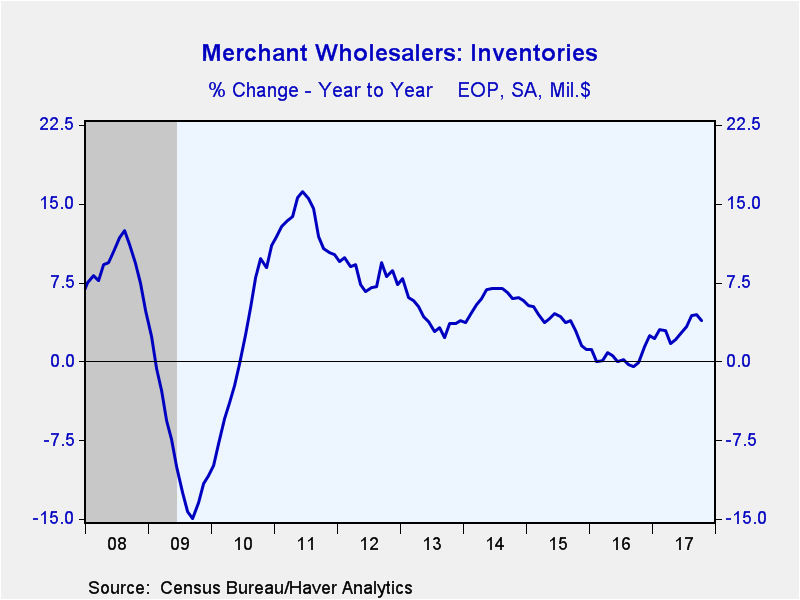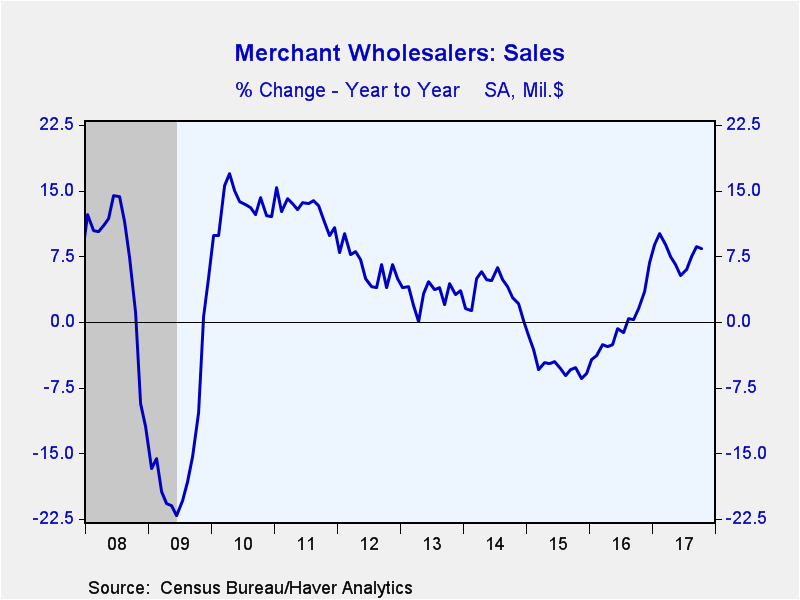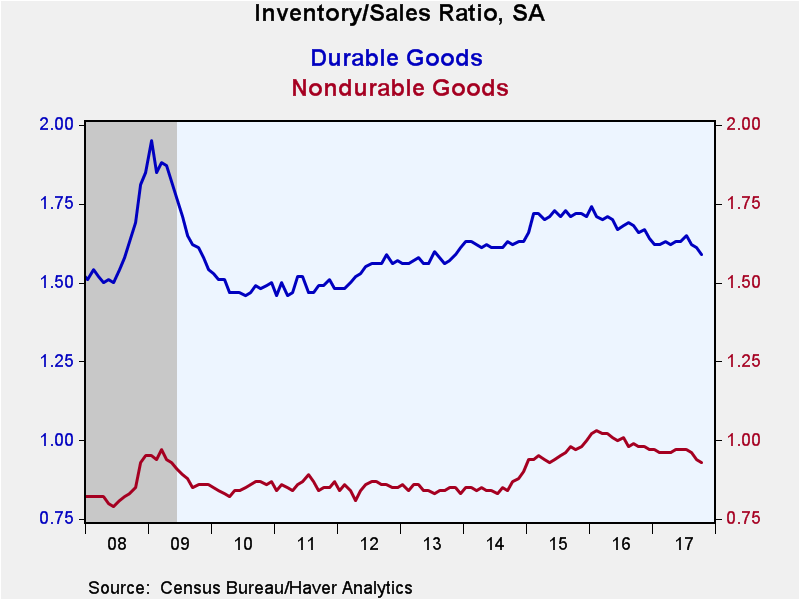 Global| Dec 08 2017
Global| Dec 08 2017U.S. Wholesale Inventories Slump; Sales Rise but Slow
by:Sandy Batten
|in:Economy in Brief
Summary
Wholesale inventories fell 0.5% m/m (+3.8% y/y) in October following a downwardly revised 0.1% m/m increase in in September (initially +0.3% m/m). The summer rebound in inventories has slowed recently. Seasonally adjusted inventories [...]
Wholesale inventories fell 0.5% m/m (+3.8% y/y) in October following a downwardly revised 0.1% m/m increase in in September (initially +0.3% m/m). The summer rebound in inventories has slowed recently. Seasonally adjusted inventories were up just 0.5% in the three months ending in October after having risen 2.1% in the three months to August. In the advance report issued on November 28, wholesale inventories were reported down 0.4% m/m in October.
Inventories of nondurable goods led the October decline. They slumped 1.3% m/m (+0.9% y/y) while inventories of durable goods edged up 0.1% m/m (+5.7% y/y). The October decline in nondurables inventories was relatively widespread across categories. Farm product raw materials inventories fell 3.7% m/m; drug inventories were down 2.5% m/m; and inventories of miscellaneous nondurable goods were off 2.2% m/m. By category, durable goods inventories were also mostly down on the month. Outsized jumps in lumber inventories (+1.7% m/m) and in metals inventories (+2.4% m/m) offset modest declines in most other categories.
Sales at the wholesale level rose in October, but continued to slow. They were up 0.7% m/m (11.6% y/y) in October versus an upwardly revised 1.4% m/m increase in September and a 1.9% m/m jump in August. A 0.3% m/m rise had been expected in the Action Economics Forecast Survey.
Sales of durable goods accounted for most (about 86%) of the October increase. They were up 1.3% m/m (14.1% y/y), while sales of nondurable goods edged up just 0.2% m/m (9.4% y/y). Of particular note for durable goods, motor vehicle sales jumped 3.4% m/m in October; lumber sales were up 3.6% m/m; and hardware sales rose 1.6% m/m. Sales of nondurable goods were mostly up across categories, but a 5.9% m/m drop (-$3.5 billion) in petroleum sales generally offset increases in all other categories.
The inventory-to-sales ratio at the wholesale level eased further to 1.25 in October, its lowest reading since December 2014 and down from a February 2016 high of 1.36.
The I/S ratio for durable goods continued it decline in October, falling to 1.59 from 1.61. The October reading was the lowest since November 2013 and well below its recent peak of 1.74 in January 2016. The recent secular decline in this ratio has been led by motor vehicle inventories, metals inventories (until recently), and machinery and equipment inventories. The I/S ratio for nondurables goods also fell in October, to 0.93 from 0.94 in September. This reading is the lowest since May 2015. The secular decline in the nondurables I/S ratio has been led by chemicals, apparel, and petroleum.
The wholesale trade figures are available in Haver's USECON database. The Action Economic Survey results are contained in AS1REPNA.
| Wholesale Sector - NAICS Classification (%) | Oct | Sep | Aug | Oct Y/Y | 2016 | 2015 | 2014 |
|---|---|---|---|---|---|---|---|
| Inventories | -0.5 | 0.1 | 0.8 | 3.8 | 2.6 | 1.1 | 5.8 |
| Sales | 0.7 | 1.4 | 1.9 | 11.6 | -0.4 | -4.9 | 3.6 |
| I/S Ratio | 1.25 | 1.26 | 1.28 | 1.30 (Oct '16) | 1.33 | 1.32 | 1.21 |
Sandy Batten
AuthorMore in Author Profile »Sandy Batten has more than 30 years of experience analyzing industrial economies and financial markets and a wide range of experience across the financial services sector, government, and academia. Before joining Haver Analytics, Sandy was a Vice President and Senior Economist at Citibank; Senior Credit Market Analyst at CDC Investment Management, Managing Director at Bear Stearns, and Executive Director at JPMorgan. In 2008, Sandy was named the most accurate US forecaster by the National Association for Business Economics. He is a member of the New York Forecasters Club, NABE, and the American Economic Association. Prior to his time in the financial services sector, Sandy was a Research Officer at the Federal Reserve Bank of St. Louis, Senior Staff Economist on the President’s Council of Economic Advisors, Deputy Assistant Secretary for Economic Policy at the US Treasury, and Economist at the International Monetary Fund. Sandy has taught economics at St. Louis University, Denison University, and Muskingun College. He has published numerous peer-reviewed articles in a wide range of academic publications. He has a B.A. in economics from the University of Richmond and a M.A. and Ph.D. in economics from The Ohio State University.










